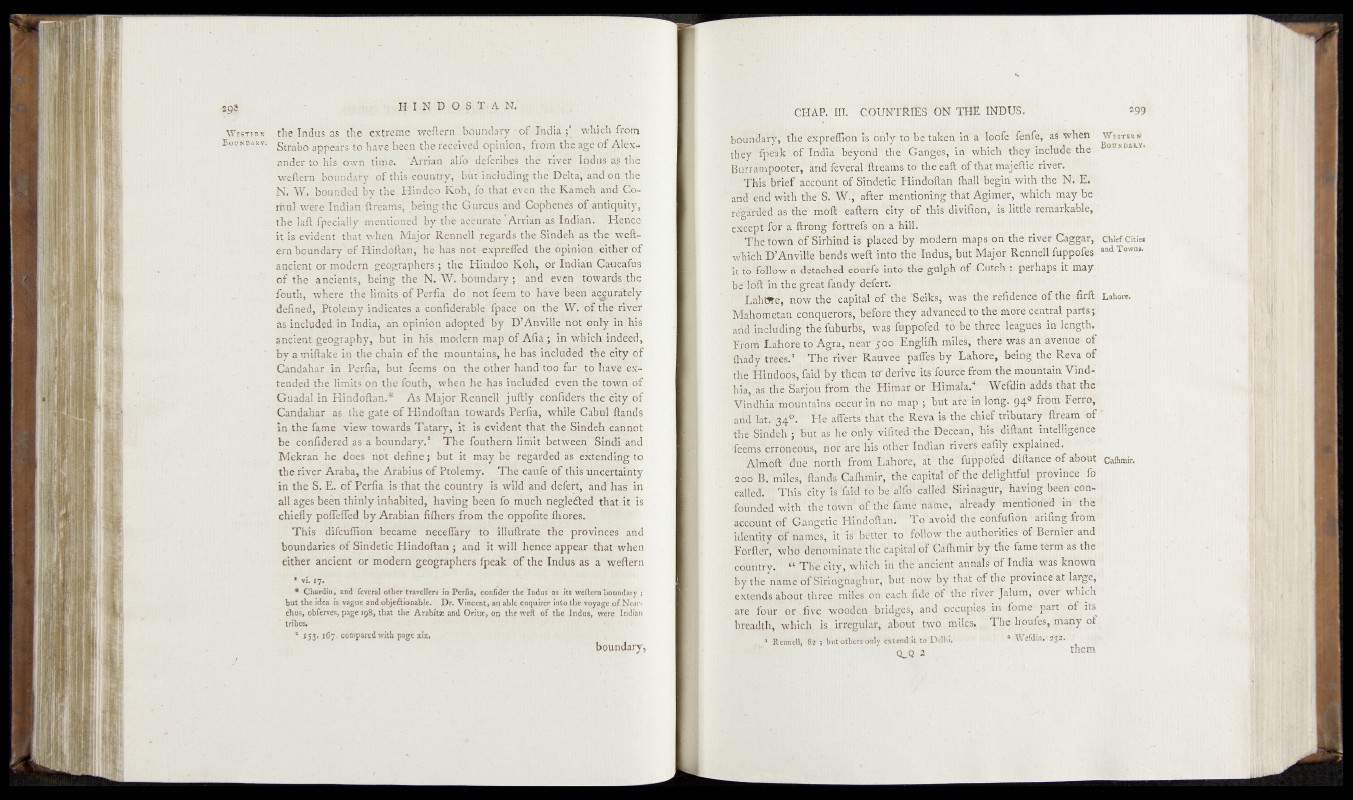
the Indus as the extreme weftçnT boundary - of India which from
Strabo agpearsto have bee| the received opinion, from the age of Alexander
to his owR,tijne. ‘Arrian alfo cfefcribes the river Indus as fhe
weftern boundary of thisdaountry, büf^wçtèdingfhe Delta,a-nd onthe
N. W. bounded by the Hindoo Koh, forthat even the Kara eh and Co-
rtmî wbre Indian ftreams; being the Gurcus and CopheneS ofa-ntiqn fly,
the laft fpecially mentioned jby the accurate 'Arrian 'Indian':', Hence
it is evident that when Major Rennell regards the Sindeh as the weft-
érn boundary'of Hindoftan, he has not expreffed thèLöpinioft either of
ancient or modern geographers ; the Hindoo Koh, or Indian Caucasus
of the ancients, be'ing the N. W. boundary-]' and even towards pie
fouth, where the limits of Perfia d o n o t feem to have been accurately
defined, Ptolemy indicates a confidérablç fpacé ion the W. of the æffijp
as included in India, opinion adopted fey Ô’ÀhviîIevnSf^prify inpiis
ancient geography, hut in his modern map] of A n a ; in which indeed,
by a miftakc in the chain of the mountain^, he has meâüderd thç city bf
CandaharTn Perfia, but feems on thé other hand too far to have .extended
the limits on the fouth, when he has included eyed the town of
Guadal in Hindoftan.* As Major Rennel-l juftly confiders the city of
Candahar-as the gate of Hindoftan,towards,Perfia, while] Jyabttf ftàhds
in the famé view towards Tatary, it is evident that the^Smueh cannot
be cbnfidered as a boundary.1 Thé föuthern limit between ‘Sfndi and
Mekran he does dpt define ; but it maybe regarded as'extending to
the river Araba, the Arabius of Ptolemy. The caufe of this uncertainty
in the S. E. of Perfia is that the çpuntry is wild ana deTert, âhd bassin
all ages been thinly inhabited, having been fo much negleéled that ff'is
chiefly poffeffed byArabian fifhers from the oppofite ftiores.
This difcuffion became neceffary to illuftrate the provinces *knd
boundaries of Sindetic Hindoftan ; and it will hence appear , that vfhen
either ancient or modern geographers fpeak of the Indus as a weftern
. . * V - -
* Chardin, and lèverai other travellers In Perfia, confider the Indus as its weftern'boundary ;
but the idea is vague and objeftionable. Dr. Vincent, an able enquirer into the voyage oF.Near-
chus, obferves, page 198, that the Arabitæ and Oritæ, on the weft o f the Indus, were Indian
tribes.
* 15 3 .167 . compared with page xix.
boundary,
bö"f)rt$afy'‘the ex^réflioti is only; to be taken in a’ foofe fenfe, as when
tlfiy ’ t|5e¥k vof L'ftdiaTAê^bndb tfib' Gafi^^éS,' in which -they include the
BêVYamppoter, and 'feVeVaFftife'^hs tbf"öie' e&ft of that'majèftic river.
‘ This b r i e f 6 f Sïifcféöt fïindöftin ftiftlPhegtif with the M2 hE.
a^& ’èhd' With the' S. W.,' after ftlgMoning that A'gimer^ which may be
refSSI&d its the mD® eaftern ‘’c i t y o f this divifiori,1 is little remarkable, '
excéht for a ftrongToftrefS on a Till.
^'T-lefown oftfurhftid is' placed by mfodefn maps oh the river .Caggar,
yhfcli D Anville bends weft into' fhè Indus, blit Major Rennell fuppofes
it fh follow a detached1 courfe ‘f&'tó thé gülph of Gutch : perhaps it may
beflriff In ffti' lahely défert.
L&htSte, n ^ r t e ^capital of the^Seiks, wai the .refidence of the dtrft
IVlÉio'ëi'etan e%iiü,eVo'rs,]beforethey advan^Ttothéiriore central parts;
eluding the fuburhs, was ffippöféd #bëfti$ee'4èagues in length.
m jL a h b f é l^ A g r a ; W a ï^ p ü English nïïles, there was an avenue’ of
fhafly frJls.9 ThVnvIr Rauvee 'paffes -by 'Lahore, being the Reva Off
f f e Hmdlés^faid by them ter derive ;it$ fourcé from the mountain Vihd-
hïaJas the Sarj oft from A é Hi maf or Himala.4' Wefdih'adds' that the
tains* olcèr in noj m a # but ale inloifgr 94° from Ferro,
and^at.’^ V ' 'f ie aflêAs^haF&e Reva is’ the chief tribütary ftream o f
the Sindeh ; but as only vifited the Deccan;ahis diftant intelligence
ffetÉni* erföheëtïs. hof1 arehis^öAW'lótllaU Tiveri eafily explained.
Almoft dye1 north from Lahore, at the ftijrpbfed diftance of aboht
mSi^Tands Gahmir, pita!’of’ the' déligfitful province' fo
cafe|Vh‘f hjs%tylffai<i tóAe'atfb' calléT fftrinagmy K'avmg'been'cón-
foftncfeci wjth thVAvri? ófVhe fanlg n$ne, alrê'ady mentioned ih the
acVoVnt of Ganfetoc'Mindofian. To léoiTthe cÖËIhftSh1 a'fifihg ®bm
idhhriVf 'of narrfèè; it' l l^ ^ e r ; to j Alio^’the authèVMiès' óf Bernier and
Förfter, Who dènorhidatè the fcafiital of Gaihmir by the fame term as the
cquntryi* ^ Tffè{lcity, which in thé adèiétt anhlls of India was known
by the name ofSiringhaghur, hut nfiw'ky fbat bf the province at large,
extends about three t miles; on each fidé óf the river jalum, over which
are four or .five wooden bridges, and .occupies in fome part of its
breadth, which is irregular, l|thout two milqs* v The houfes, many of
.^ 3 Rennell, 8? ;'butótlièrs?ö'hiy eklêWdït tc>;;DëlHi.■ 4 Wcfdiii, 2'32.
O^q. 2 i ; ■ them
W e st e r s
B o unda ry.
Chief Cities
and Towns.
Lahore.
Caflimir.